Cultural Anthropology: Zika Virus - Outbreak, Spread, and Management
VerifiedAdded on 2023/06/10
|9
|2580
|53
Report
AI Summary
This report provides a comprehensive analysis of the Zika virus outbreak from a cultural anthropology perspective. It explores the unexpected nature of the outbreak, its origins in Ontario, Canada, and the various factors that facilitated its spread, including weather conditions, mosquito vectors, urbanization, and global travel. The report examines the geographic distribution of the disease, its potential to become a global pandemic, and the challenges in managing it, such as controlling mosquito populations and addressing socioeconomic factors. It also discusses the influence of public reaction, both within and outside affected areas, on the impact and management of the disease. The report concludes that while Zika poses a significant global health threat due to its rapid spread, lack of vaccines, and association with birth defects, a combination of governmental strategies and public awareness can lead to better disease management through precautionary measures like preventing mosquito bites and controlling mosquito populations. Desklib offers similar resources for students.

Running head: Cultural Anthropology
Cultural Anthropology
Name of the Student
Name of the University
Author Note
Cultural Anthropology
Name of the Student
Name of the University
Author Note
Paraphrase This Document
Need a fresh take? Get an instant paraphrase of this document with our AI Paraphraser
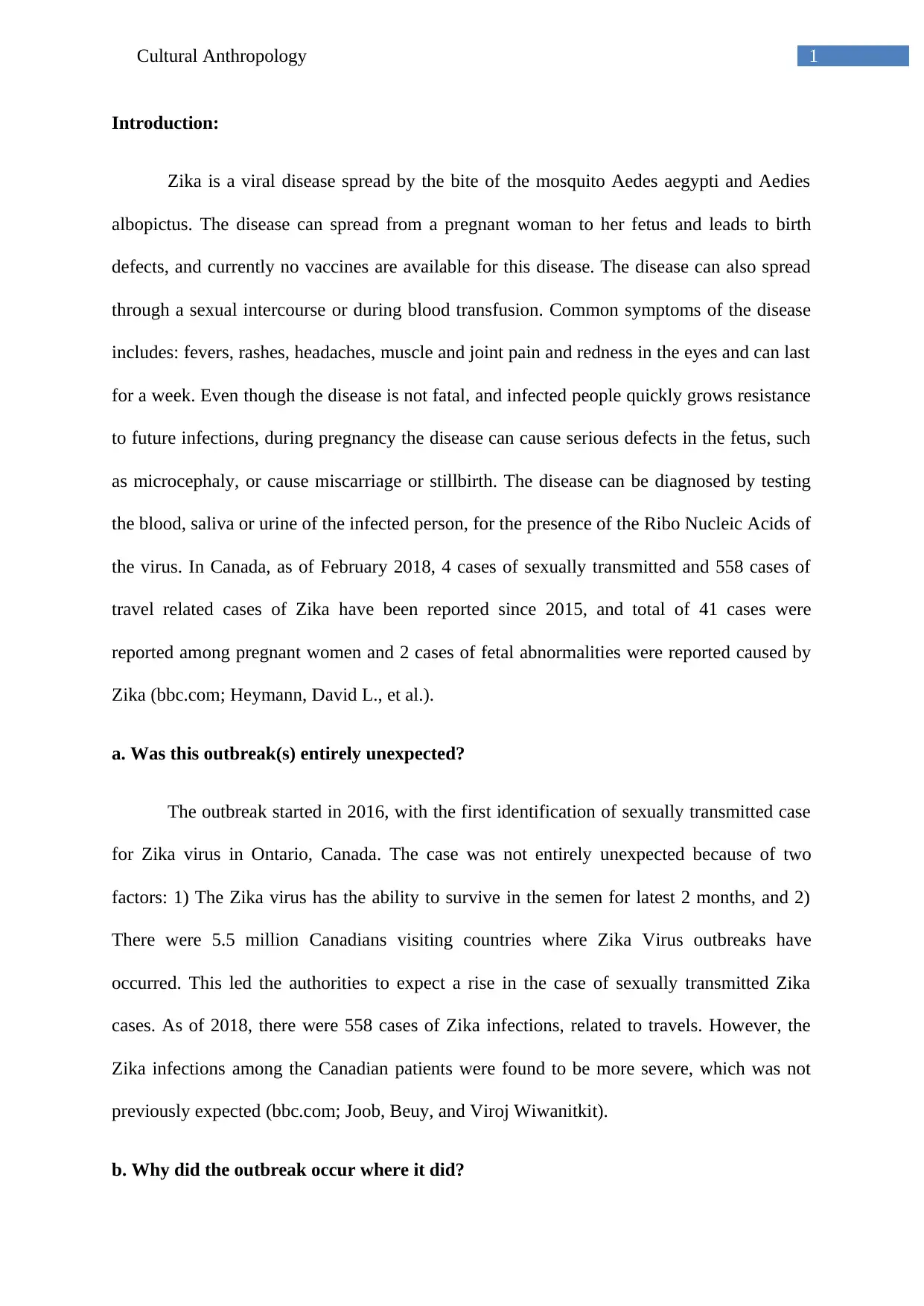
1Cultural Anthropology
Introduction:
Zika is a viral disease spread by the bite of the mosquito Aedes aegypti and Aedies
albopictus. The disease can spread from a pregnant woman to her fetus and leads to birth
defects, and currently no vaccines are available for this disease. The disease can also spread
through a sexual intercourse or during blood transfusion. Common symptoms of the disease
includes: fevers, rashes, headaches, muscle and joint pain and redness in the eyes and can last
for a week. Even though the disease is not fatal, and infected people quickly grows resistance
to future infections, during pregnancy the disease can cause serious defects in the fetus, such
as microcephaly, or cause miscarriage or stillbirth. The disease can be diagnosed by testing
the blood, saliva or urine of the infected person, for the presence of the Ribo Nucleic Acids of
the virus. In Canada, as of February 2018, 4 cases of sexually transmitted and 558 cases of
travel related cases of Zika have been reported since 2015, and total of 41 cases were
reported among pregnant women and 2 cases of fetal abnormalities were reported caused by
Zika (bbc.com; Heymann, David L., et al.).
a. Was this outbreak(s) entirely unexpected?
The outbreak started in 2016, with the first identification of sexually transmitted case
for Zika virus in Ontario, Canada. The case was not entirely unexpected because of two
factors: 1) The Zika virus has the ability to survive in the semen for latest 2 months, and 2)
There were 5.5 million Canadians visiting countries where Zika Virus outbreaks have
occurred. This led the authorities to expect a rise in the case of sexually transmitted Zika
cases. As of 2018, there were 558 cases of Zika infections, related to travels. However, the
Zika infections among the Canadian patients were found to be more severe, which was not
previously expected (bbc.com; Joob, Beuy, and Viroj Wiwanitkit).
b. Why did the outbreak occur where it did?
Introduction:
Zika is a viral disease spread by the bite of the mosquito Aedes aegypti and Aedies
albopictus. The disease can spread from a pregnant woman to her fetus and leads to birth
defects, and currently no vaccines are available for this disease. The disease can also spread
through a sexual intercourse or during blood transfusion. Common symptoms of the disease
includes: fevers, rashes, headaches, muscle and joint pain and redness in the eyes and can last
for a week. Even though the disease is not fatal, and infected people quickly grows resistance
to future infections, during pregnancy the disease can cause serious defects in the fetus, such
as microcephaly, or cause miscarriage or stillbirth. The disease can be diagnosed by testing
the blood, saliva or urine of the infected person, for the presence of the Ribo Nucleic Acids of
the virus. In Canada, as of February 2018, 4 cases of sexually transmitted and 558 cases of
travel related cases of Zika have been reported since 2015, and total of 41 cases were
reported among pregnant women and 2 cases of fetal abnormalities were reported caused by
Zika (bbc.com; Heymann, David L., et al.).
a. Was this outbreak(s) entirely unexpected?
The outbreak started in 2016, with the first identification of sexually transmitted case
for Zika virus in Ontario, Canada. The case was not entirely unexpected because of two
factors: 1) The Zika virus has the ability to survive in the semen for latest 2 months, and 2)
There were 5.5 million Canadians visiting countries where Zika Virus outbreaks have
occurred. This led the authorities to expect a rise in the case of sexually transmitted Zika
cases. As of 2018, there were 558 cases of Zika infections, related to travels. However, the
Zika infections among the Canadian patients were found to be more severe, which was not
previously expected (bbc.com; Joob, Beuy, and Viroj Wiwanitkit).
b. Why did the outbreak occur where it did?

2Cultural Anthropology
The outbreak started from Ontario, Canada, with the report of a woman contacting the
disease from her male partner, who was infected after visiting a country affected by the Zika
epidemic (Borgia, Sergio, et al.). The outbreak was made possible due to the high number of
Canadian travelers to countries affected by Zika, making them the carriers of the disease. The
Global outbreak started in Brazil on 2016, and since then it spread to 42 countries, mainly in
Caribbean and Latin American Countries, and cases of sexually transmitted Zika virus have
also been reported in 8 countries. However, the first case of Zika was reported in 2011 in a
scientist from Colorado on a visit to Senegal for a research (Heukelbach, Jorg, et al).
c. What are the factors that might facilitate an outbreak of this disease?
According to Gulich, Getahun Asebe, the outbreak of Zika was driven by several factors:
1. Weather and climatic condition: Increasing temperatures favoring the spread of mosquito
borne diseases increased the chances of the Zika virus, which is also mosquito borne.
2. Presence of disease carrying vectors: Increase in the range and abundance of the Aedes
mosquitoes allowed it to spread successfully in the northern and southern hemispheres,
increasing the spread of Zika.
3. Ecosystem and other factors: Factors such as deforestation, spread of mosquitoes and the
susceptibility towards the diseases have helped the outbreak. Also swampy ecosystems
provided the mosquitoes for ideal breeding grounds, thus increasing its population and spread
of disease.
4. Travelling: Diseases spread more rapidly, transmitted by the travelers who travel across
the globe, visiting affected countries and carrying it to other countries.
The outbreak started from Ontario, Canada, with the report of a woman contacting the
disease from her male partner, who was infected after visiting a country affected by the Zika
epidemic (Borgia, Sergio, et al.). The outbreak was made possible due to the high number of
Canadian travelers to countries affected by Zika, making them the carriers of the disease. The
Global outbreak started in Brazil on 2016, and since then it spread to 42 countries, mainly in
Caribbean and Latin American Countries, and cases of sexually transmitted Zika virus have
also been reported in 8 countries. However, the first case of Zika was reported in 2011 in a
scientist from Colorado on a visit to Senegal for a research (Heukelbach, Jorg, et al).
c. What are the factors that might facilitate an outbreak of this disease?
According to Gulich, Getahun Asebe, the outbreak of Zika was driven by several factors:
1. Weather and climatic condition: Increasing temperatures favoring the spread of mosquito
borne diseases increased the chances of the Zika virus, which is also mosquito borne.
2. Presence of disease carrying vectors: Increase in the range and abundance of the Aedes
mosquitoes allowed it to spread successfully in the northern and southern hemispheres,
increasing the spread of Zika.
3. Ecosystem and other factors: Factors such as deforestation, spread of mosquitoes and the
susceptibility towards the diseases have helped the outbreak. Also swampy ecosystems
provided the mosquitoes for ideal breeding grounds, thus increasing its population and spread
of disease.
4. Travelling: Diseases spread more rapidly, transmitted by the travelers who travel across
the globe, visiting affected countries and carrying it to other countries.
⊘ This is a preview!⊘
Do you want full access?
Subscribe today to unlock all pages.

Trusted by 1+ million students worldwide
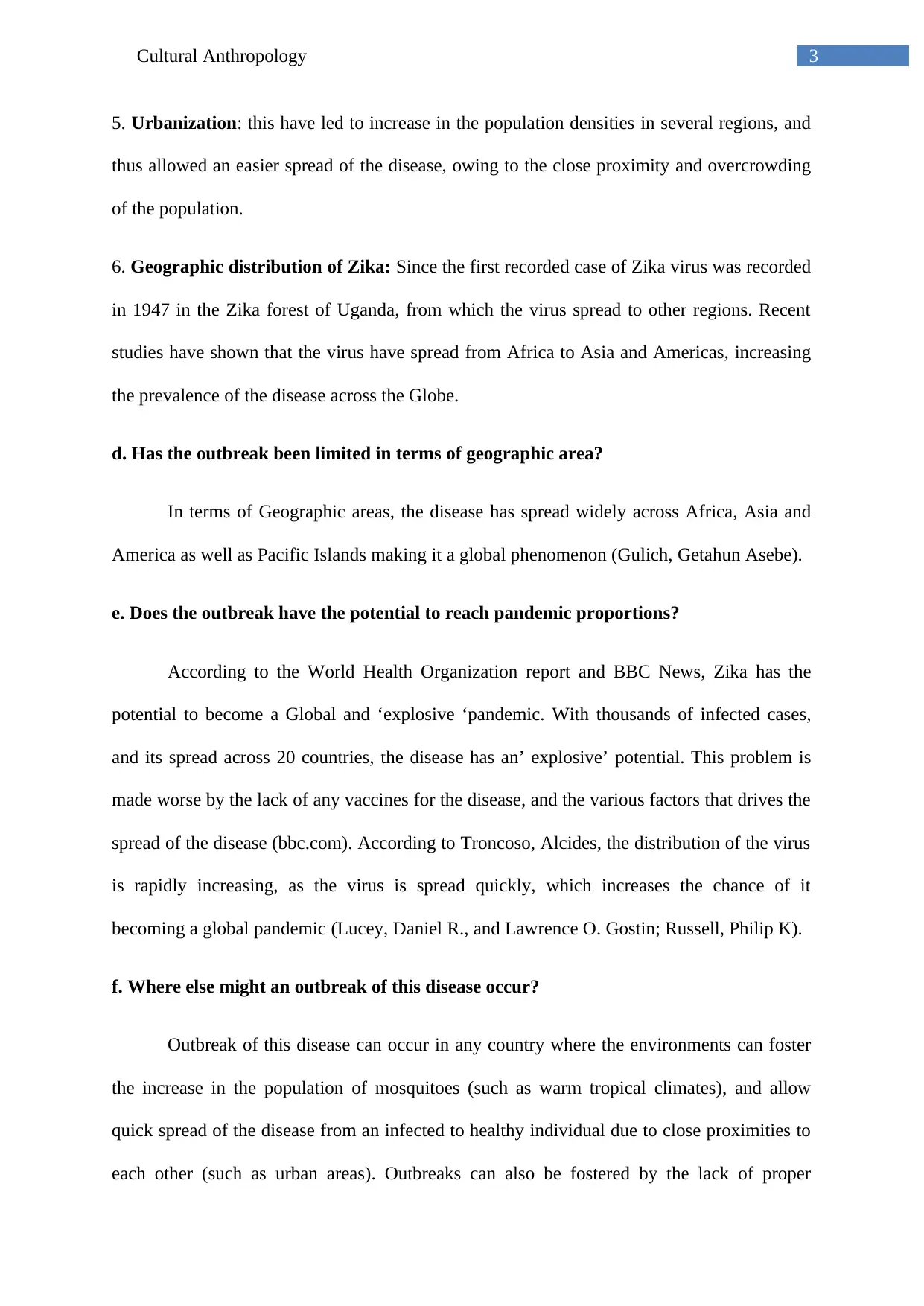
3Cultural Anthropology
5. Urbanization: this have led to increase in the population densities in several regions, and
thus allowed an easier spread of the disease, owing to the close proximity and overcrowding
of the population.
6. Geographic distribution of Zika: Since the first recorded case of Zika virus was recorded
in 1947 in the Zika forest of Uganda, from which the virus spread to other regions. Recent
studies have shown that the virus have spread from Africa to Asia and Americas, increasing
the prevalence of the disease across the Globe.
d. Has the outbreak been limited in terms of geographic area?
In terms of Geographic areas, the disease has spread widely across Africa, Asia and
America as well as Pacific Islands making it a global phenomenon (Gulich, Getahun Asebe).
e. Does the outbreak have the potential to reach pandemic proportions?
According to the World Health Organization report and BBC News, Zika has the
potential to become a Global and ‘explosive ‘pandemic. With thousands of infected cases,
and its spread across 20 countries, the disease has an’ explosive’ potential. This problem is
made worse by the lack of any vaccines for the disease, and the various factors that drives the
spread of the disease (bbc.com). According to Troncoso, Alcides, the distribution of the virus
is rapidly increasing, as the virus is spread quickly, which increases the chance of it
becoming a global pandemic (Lucey, Daniel R., and Lawrence O. Gostin; Russell, Philip K).
f. Where else might an outbreak of this disease occur?
Outbreak of this disease can occur in any country where the environments can foster
the increase in the population of mosquitoes (such as warm tropical climates), and allow
quick spread of the disease from an infected to healthy individual due to close proximities to
each other (such as urban areas). Outbreaks can also be fostered by the lack of proper
5. Urbanization: this have led to increase in the population densities in several regions, and
thus allowed an easier spread of the disease, owing to the close proximity and overcrowding
of the population.
6. Geographic distribution of Zika: Since the first recorded case of Zika virus was recorded
in 1947 in the Zika forest of Uganda, from which the virus spread to other regions. Recent
studies have shown that the virus have spread from Africa to Asia and Americas, increasing
the prevalence of the disease across the Globe.
d. Has the outbreak been limited in terms of geographic area?
In terms of Geographic areas, the disease has spread widely across Africa, Asia and
America as well as Pacific Islands making it a global phenomenon (Gulich, Getahun Asebe).
e. Does the outbreak have the potential to reach pandemic proportions?
According to the World Health Organization report and BBC News, Zika has the
potential to become a Global and ‘explosive ‘pandemic. With thousands of infected cases,
and its spread across 20 countries, the disease has an’ explosive’ potential. This problem is
made worse by the lack of any vaccines for the disease, and the various factors that drives the
spread of the disease (bbc.com). According to Troncoso, Alcides, the distribution of the virus
is rapidly increasing, as the virus is spread quickly, which increases the chance of it
becoming a global pandemic (Lucey, Daniel R., and Lawrence O. Gostin; Russell, Philip K).
f. Where else might an outbreak of this disease occur?
Outbreak of this disease can occur in any country where the environments can foster
the increase in the population of mosquitoes (such as warm tropical climates), and allow
quick spread of the disease from an infected to healthy individual due to close proximities to
each other (such as urban areas). Outbreaks can also be fostered by the lack of proper
Paraphrase This Document
Need a fresh take? Get an instant paraphrase of this document with our AI Paraphraser

4Cultural Anthropology
treatment options and socioeconomic or economic factors which might challenge the
provision of precautionary measures. According to the Government of Canada, there are 71
countries that are at risk of Zika outbreaks across the world (Canada.ca).
g. Is this disease readily identifiable and treatable?
Identification of Zika infection is difficult since most cases can be asymptomatic,
thereby preventing its accurate diagnosis. The common symptoms can include fever,
headaches, rashes, joint pain, muscle pain and redness of the eyes, which are also caused by
many other diseases. Effective identification can be done only after assessing the medical
history, travel history, including trips made by the sexual partners. The treatment for the
disease does not exist, as there are no known vaccines, and current treatment practice aims
towards relieving the symptoms using rest, medication and fluid replacement therapies
(Shuaib, Waqas, et al.).
h. What are means of managing this disease once it breaks out in a human population?
Once an outbreak of Zika occurs in a human population different control measures
can be taken to prevent its further spread and transmission. AT the population level, measures
to control the vectors (mosquito) includes: basic sanitation, eliminating the source of vectors,
preventing the accumulation of garbage, using various control methods (chemical, biological
or physical) to control vector population. At personal levels, preventative and protective
measures can include steps that can prevent mosquito bites (Falcao, Melissa Barreto, et al).
i. Can this disease be effectively managed?
Managing the disease is a tricky challenge, considering the various factors that drives
its prevalence, such as weather, climatic conditions, ecological factors, prevalence of the
vectors, geographic distribution of the virus as well as human factors (such as travelling and
treatment options and socioeconomic or economic factors which might challenge the
provision of precautionary measures. According to the Government of Canada, there are 71
countries that are at risk of Zika outbreaks across the world (Canada.ca).
g. Is this disease readily identifiable and treatable?
Identification of Zika infection is difficult since most cases can be asymptomatic,
thereby preventing its accurate diagnosis. The common symptoms can include fever,
headaches, rashes, joint pain, muscle pain and redness of the eyes, which are also caused by
many other diseases. Effective identification can be done only after assessing the medical
history, travel history, including trips made by the sexual partners. The treatment for the
disease does not exist, as there are no known vaccines, and current treatment practice aims
towards relieving the symptoms using rest, medication and fluid replacement therapies
(Shuaib, Waqas, et al.).
h. What are means of managing this disease once it breaks out in a human population?
Once an outbreak of Zika occurs in a human population different control measures
can be taken to prevent its further spread and transmission. AT the population level, measures
to control the vectors (mosquito) includes: basic sanitation, eliminating the source of vectors,
preventing the accumulation of garbage, using various control methods (chemical, biological
or physical) to control vector population. At personal levels, preventative and protective
measures can include steps that can prevent mosquito bites (Falcao, Melissa Barreto, et al).
i. Can this disease be effectively managed?
Managing the disease is a tricky challenge, considering the various factors that drives
its prevalence, such as weather, climatic conditions, ecological factors, prevalence of the
vectors, geographic distribution of the virus as well as human factors (such as travelling and
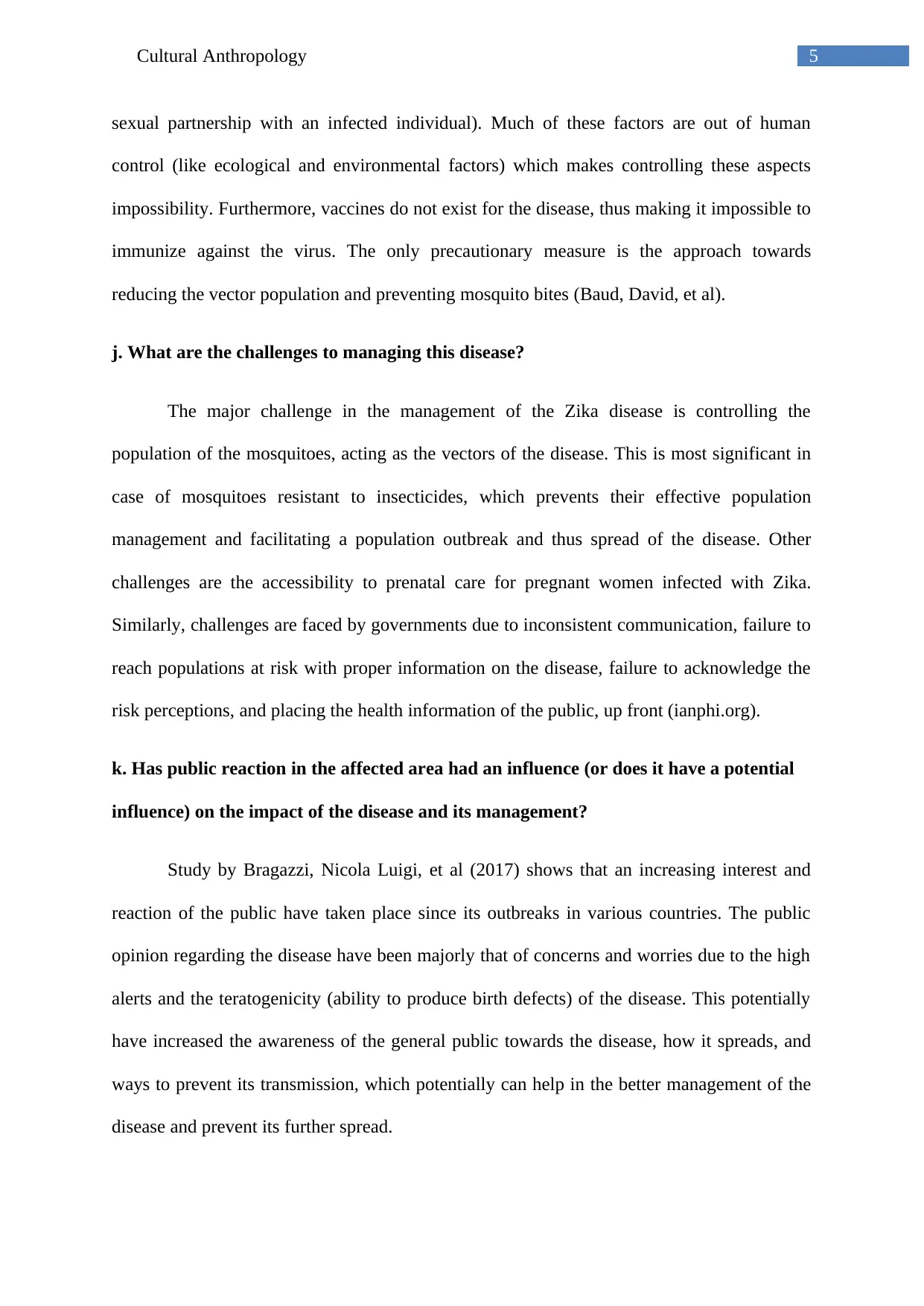
5Cultural Anthropology
sexual partnership with an infected individual). Much of these factors are out of human
control (like ecological and environmental factors) which makes controlling these aspects
impossibility. Furthermore, vaccines do not exist for the disease, thus making it impossible to
immunize against the virus. The only precautionary measure is the approach towards
reducing the vector population and preventing mosquito bites (Baud, David, et al).
j. What are the challenges to managing this disease?
The major challenge in the management of the Zika disease is controlling the
population of the mosquitoes, acting as the vectors of the disease. This is most significant in
case of mosquitoes resistant to insecticides, which prevents their effective population
management and facilitating a population outbreak and thus spread of the disease. Other
challenges are the accessibility to prenatal care for pregnant women infected with Zika.
Similarly, challenges are faced by governments due to inconsistent communication, failure to
reach populations at risk with proper information on the disease, failure to acknowledge the
risk perceptions, and placing the health information of the public, up front (ianphi.org).
k. Has public reaction in the affected area had an influence (or does it have a potential
influence) on the impact of the disease and its management?
Study by Bragazzi, Nicola Luigi, et al (2017) shows that an increasing interest and
reaction of the public have taken place since its outbreaks in various countries. The public
opinion regarding the disease have been majorly that of concerns and worries due to the high
alerts and the teratogenicity (ability to produce birth defects) of the disease. This potentially
have increased the awareness of the general public towards the disease, how it spreads, and
ways to prevent its transmission, which potentially can help in the better management of the
disease and prevent its further spread.
sexual partnership with an infected individual). Much of these factors are out of human
control (like ecological and environmental factors) which makes controlling these aspects
impossibility. Furthermore, vaccines do not exist for the disease, thus making it impossible to
immunize against the virus. The only precautionary measure is the approach towards
reducing the vector population and preventing mosquito bites (Baud, David, et al).
j. What are the challenges to managing this disease?
The major challenge in the management of the Zika disease is controlling the
population of the mosquitoes, acting as the vectors of the disease. This is most significant in
case of mosquitoes resistant to insecticides, which prevents their effective population
management and facilitating a population outbreak and thus spread of the disease. Other
challenges are the accessibility to prenatal care for pregnant women infected with Zika.
Similarly, challenges are faced by governments due to inconsistent communication, failure to
reach populations at risk with proper information on the disease, failure to acknowledge the
risk perceptions, and placing the health information of the public, up front (ianphi.org).
k. Has public reaction in the affected area had an influence (or does it have a potential
influence) on the impact of the disease and its management?
Study by Bragazzi, Nicola Luigi, et al (2017) shows that an increasing interest and
reaction of the public have taken place since its outbreaks in various countries. The public
opinion regarding the disease have been majorly that of concerns and worries due to the high
alerts and the teratogenicity (ability to produce birth defects) of the disease. This potentially
have increased the awareness of the general public towards the disease, how it spreads, and
ways to prevent its transmission, which potentially can help in the better management of the
disease and prevent its further spread.
⊘ This is a preview!⊘
Do you want full access?
Subscribe today to unlock all pages.

Trusted by 1+ million students worldwide
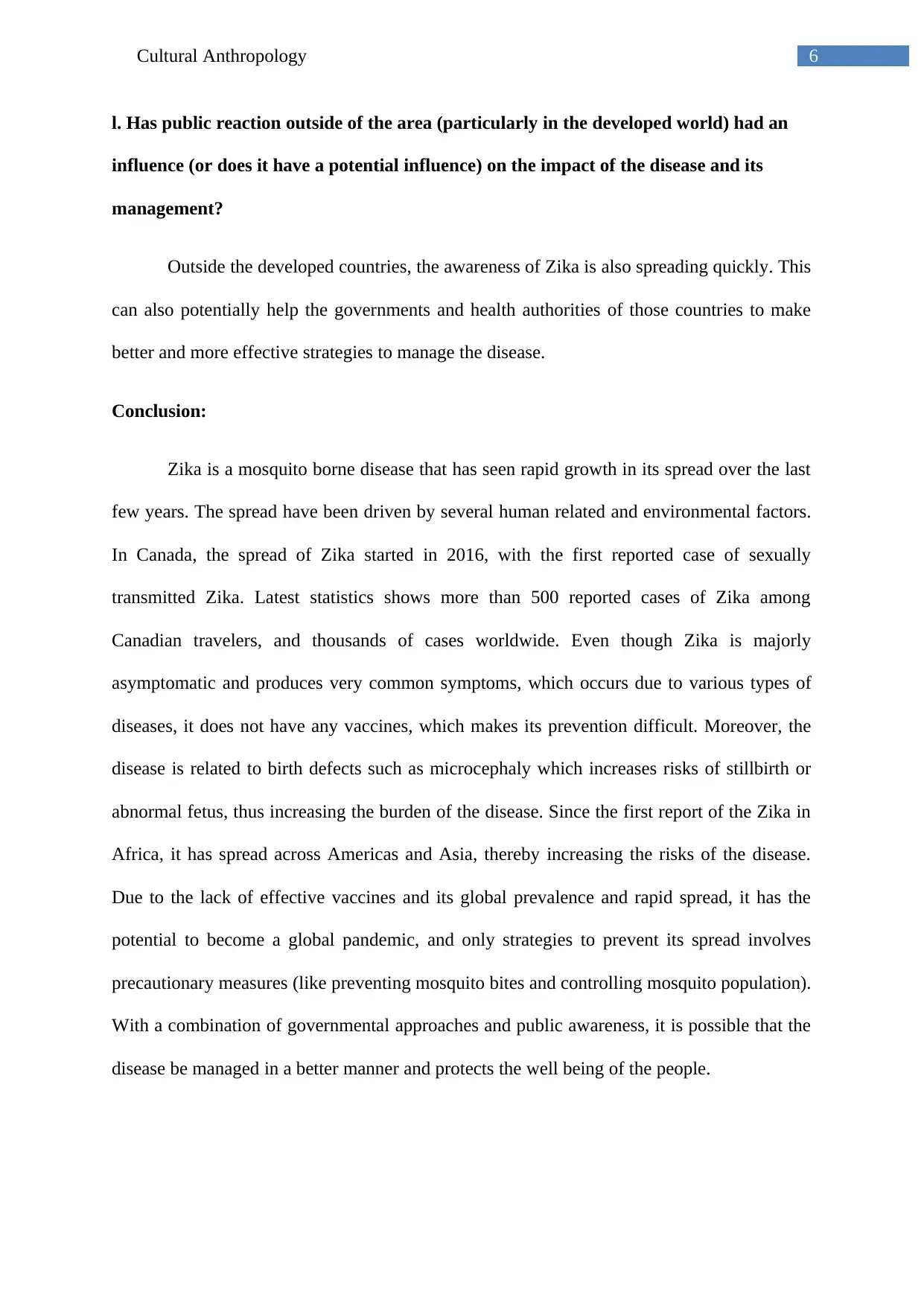
6Cultural Anthropology
l. Has public reaction outside of the area (particularly in the developed world) had an
influence (or does it have a potential influence) on the impact of the disease and its
management?
Outside the developed countries, the awareness of Zika is also spreading quickly. This
can also potentially help the governments and health authorities of those countries to make
better and more effective strategies to manage the disease.
Conclusion:
Zika is a mosquito borne disease that has seen rapid growth in its spread over the last
few years. The spread have been driven by several human related and environmental factors.
In Canada, the spread of Zika started in 2016, with the first reported case of sexually
transmitted Zika. Latest statistics shows more than 500 reported cases of Zika among
Canadian travelers, and thousands of cases worldwide. Even though Zika is majorly
asymptomatic and produces very common symptoms, which occurs due to various types of
diseases, it does not have any vaccines, which makes its prevention difficult. Moreover, the
disease is related to birth defects such as microcephaly which increases risks of stillbirth or
abnormal fetus, thus increasing the burden of the disease. Since the first report of the Zika in
Africa, it has spread across Americas and Asia, thereby increasing the risks of the disease.
Due to the lack of effective vaccines and its global prevalence and rapid spread, it has the
potential to become a global pandemic, and only strategies to prevent its spread involves
precautionary measures (like preventing mosquito bites and controlling mosquito population).
With a combination of governmental approaches and public awareness, it is possible that the
disease be managed in a better manner and protects the well being of the people.
l. Has public reaction outside of the area (particularly in the developed world) had an
influence (or does it have a potential influence) on the impact of the disease and its
management?
Outside the developed countries, the awareness of Zika is also spreading quickly. This
can also potentially help the governments and health authorities of those countries to make
better and more effective strategies to manage the disease.
Conclusion:
Zika is a mosquito borne disease that has seen rapid growth in its spread over the last
few years. The spread have been driven by several human related and environmental factors.
In Canada, the spread of Zika started in 2016, with the first reported case of sexually
transmitted Zika. Latest statistics shows more than 500 reported cases of Zika among
Canadian travelers, and thousands of cases worldwide. Even though Zika is majorly
asymptomatic and produces very common symptoms, which occurs due to various types of
diseases, it does not have any vaccines, which makes its prevention difficult. Moreover, the
disease is related to birth defects such as microcephaly which increases risks of stillbirth or
abnormal fetus, thus increasing the burden of the disease. Since the first report of the Zika in
Africa, it has spread across Americas and Asia, thereby increasing the risks of the disease.
Due to the lack of effective vaccines and its global prevalence and rapid spread, it has the
potential to become a global pandemic, and only strategies to prevent its spread involves
precautionary measures (like preventing mosquito bites and controlling mosquito population).
With a combination of governmental approaches and public awareness, it is possible that the
disease be managed in a better manner and protects the well being of the people.
Paraphrase This Document
Need a fresh take? Get an instant paraphrase of this document with our AI Paraphraser
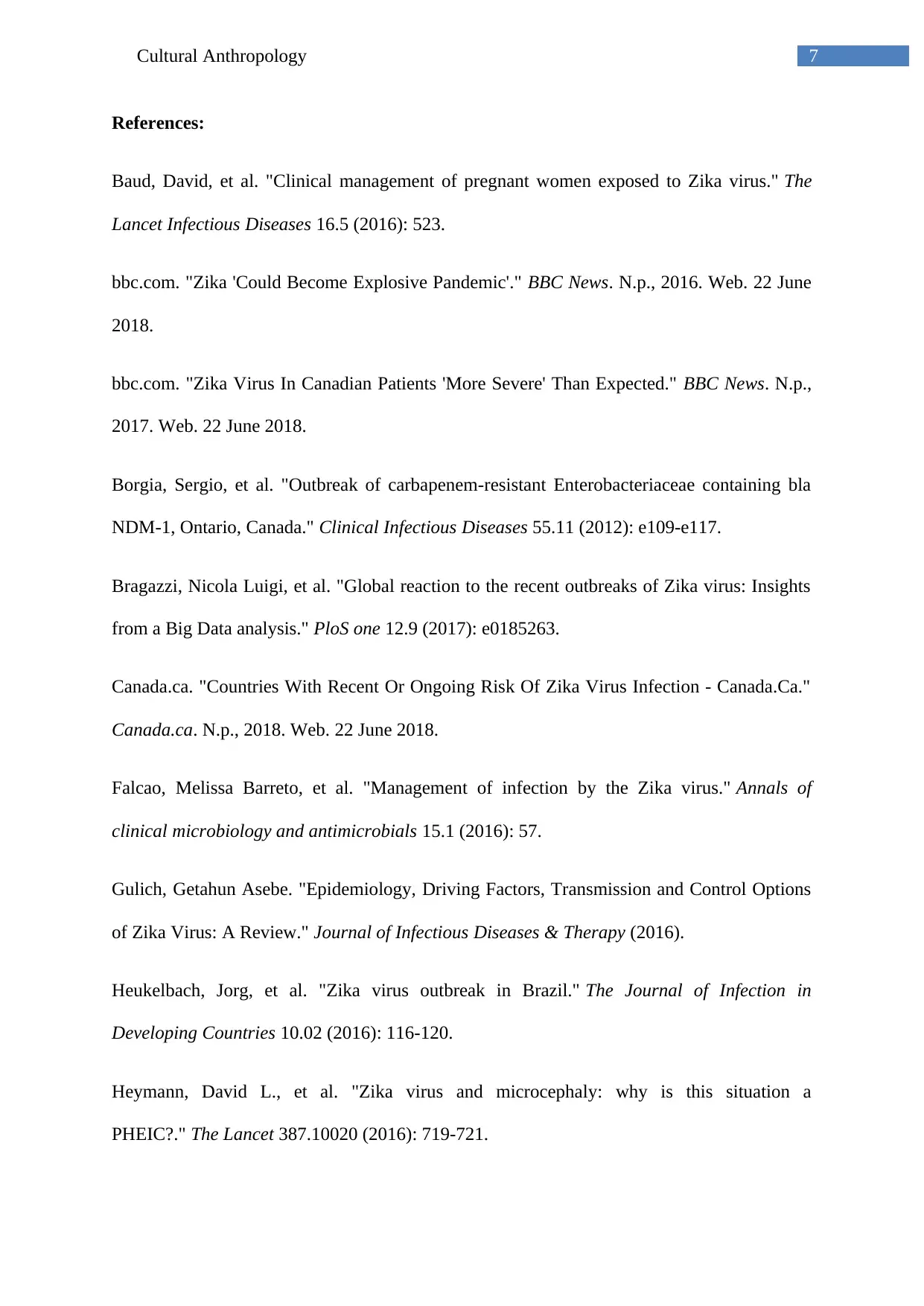
7Cultural Anthropology
References:
Baud, David, et al. "Clinical management of pregnant women exposed to Zika virus." The
Lancet Infectious Diseases 16.5 (2016): 523.
bbc.com. "Zika 'Could Become Explosive Pandemic'." BBC News. N.p., 2016. Web. 22 June
2018.
bbc.com. "Zika Virus In Canadian Patients 'More Severe' Than Expected." BBC News. N.p.,
2017. Web. 22 June 2018.
Borgia, Sergio, et al. "Outbreak of carbapenem-resistant Enterobacteriaceae containing bla
NDM-1, Ontario, Canada." Clinical Infectious Diseases 55.11 (2012): e109-e117.
Bragazzi, Nicola Luigi, et al. "Global reaction to the recent outbreaks of Zika virus: Insights
from a Big Data analysis." PloS one 12.9 (2017): e0185263.
Canada.ca. "Countries With Recent Or Ongoing Risk Of Zika Virus Infection - Canada.Ca."
Canada.ca. N.p., 2018. Web. 22 June 2018.
Falcao, Melissa Barreto, et al. "Management of infection by the Zika virus." Annals of
clinical microbiology and antimicrobials 15.1 (2016): 57.
Gulich, Getahun Asebe. "Epidemiology, Driving Factors, Transmission and Control Options
of Zika Virus: A Review." Journal of Infectious Diseases & Therapy (2016).
Heukelbach, Jorg, et al. "Zika virus outbreak in Brazil." The Journal of Infection in
Developing Countries 10.02 (2016): 116-120.
Heymann, David L., et al. "Zika virus and microcephaly: why is this situation a
PHEIC?." The Lancet 387.10020 (2016): 719-721.
References:
Baud, David, et al. "Clinical management of pregnant women exposed to Zika virus." The
Lancet Infectious Diseases 16.5 (2016): 523.
bbc.com. "Zika 'Could Become Explosive Pandemic'." BBC News. N.p., 2016. Web. 22 June
2018.
bbc.com. "Zika Virus In Canadian Patients 'More Severe' Than Expected." BBC News. N.p.,
2017. Web. 22 June 2018.
Borgia, Sergio, et al. "Outbreak of carbapenem-resistant Enterobacteriaceae containing bla
NDM-1, Ontario, Canada." Clinical Infectious Diseases 55.11 (2012): e109-e117.
Bragazzi, Nicola Luigi, et al. "Global reaction to the recent outbreaks of Zika virus: Insights
from a Big Data analysis." PloS one 12.9 (2017): e0185263.
Canada.ca. "Countries With Recent Or Ongoing Risk Of Zika Virus Infection - Canada.Ca."
Canada.ca. N.p., 2018. Web. 22 June 2018.
Falcao, Melissa Barreto, et al. "Management of infection by the Zika virus." Annals of
clinical microbiology and antimicrobials 15.1 (2016): 57.
Gulich, Getahun Asebe. "Epidemiology, Driving Factors, Transmission and Control Options
of Zika Virus: A Review." Journal of Infectious Diseases & Therapy (2016).
Heukelbach, Jorg, et al. "Zika virus outbreak in Brazil." The Journal of Infection in
Developing Countries 10.02 (2016): 116-120.
Heymann, David L., et al. "Zika virus and microcephaly: why is this situation a
PHEIC?." The Lancet 387.10020 (2016): 719-721.
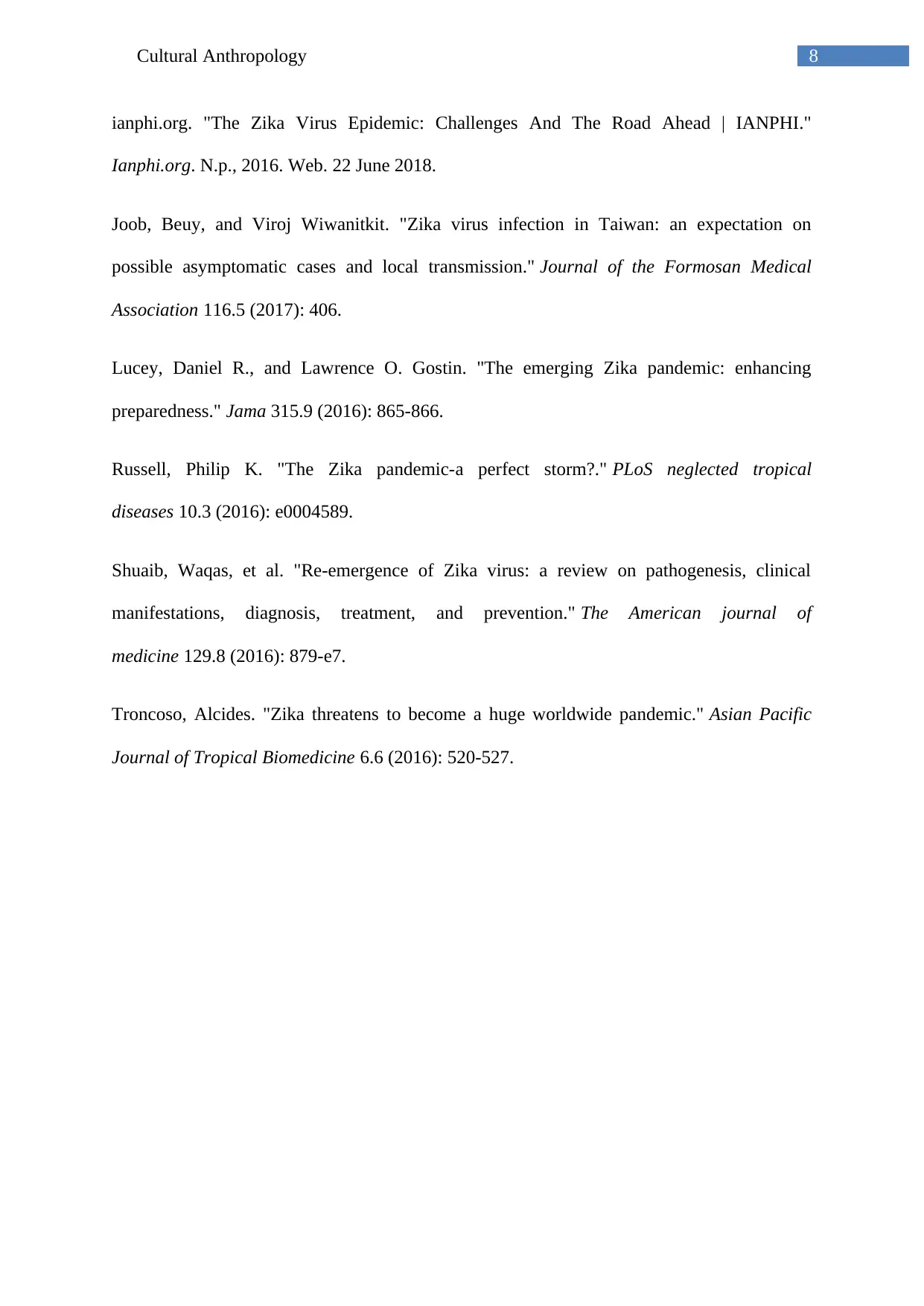
8Cultural Anthropology
ianphi.org. "The Zika Virus Epidemic: Challenges And The Road Ahead | IANPHI."
Ianphi.org. N.p., 2016. Web. 22 June 2018.
Joob, Beuy, and Viroj Wiwanitkit. "Zika virus infection in Taiwan: an expectation on
possible asymptomatic cases and local transmission." Journal of the Formosan Medical
Association 116.5 (2017): 406.
Lucey, Daniel R., and Lawrence O. Gostin. "The emerging Zika pandemic: enhancing
preparedness." Jama 315.9 (2016): 865-866.
Russell, Philip K. "The Zika pandemic-a perfect storm?." PLoS neglected tropical
diseases 10.3 (2016): e0004589.
Shuaib, Waqas, et al. "Re-emergence of Zika virus: a review on pathogenesis, clinical
manifestations, diagnosis, treatment, and prevention." The American journal of
medicine 129.8 (2016): 879-e7.
Troncoso, Alcides. "Zika threatens to become a huge worldwide pandemic." Asian Pacific
Journal of Tropical Biomedicine 6.6 (2016): 520-527.
ianphi.org. "The Zika Virus Epidemic: Challenges And The Road Ahead | IANPHI."
Ianphi.org. N.p., 2016. Web. 22 June 2018.
Joob, Beuy, and Viroj Wiwanitkit. "Zika virus infection in Taiwan: an expectation on
possible asymptomatic cases and local transmission." Journal of the Formosan Medical
Association 116.5 (2017): 406.
Lucey, Daniel R., and Lawrence O. Gostin. "The emerging Zika pandemic: enhancing
preparedness." Jama 315.9 (2016): 865-866.
Russell, Philip K. "The Zika pandemic-a perfect storm?." PLoS neglected tropical
diseases 10.3 (2016): e0004589.
Shuaib, Waqas, et al. "Re-emergence of Zika virus: a review on pathogenesis, clinical
manifestations, diagnosis, treatment, and prevention." The American journal of
medicine 129.8 (2016): 879-e7.
Troncoso, Alcides. "Zika threatens to become a huge worldwide pandemic." Asian Pacific
Journal of Tropical Biomedicine 6.6 (2016): 520-527.
⊘ This is a preview!⊘
Do you want full access?
Subscribe today to unlock all pages.

Trusted by 1+ million students worldwide
1 out of 9
Your All-in-One AI-Powered Toolkit for Academic Success.
+13062052269
info@desklib.com
Available 24*7 on WhatsApp / Email
![[object Object]](/_next/static/media/star-bottom.7253800d.svg)
Unlock your academic potential
Copyright © 2020–2025 A2Z Services. All Rights Reserved. Developed and managed by ZUCOL.